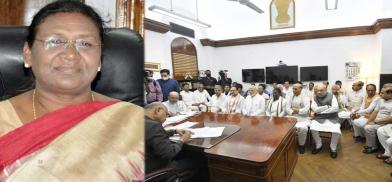BJP fields an Adivasi president: A political masterstroke by Modi
It’s a win-win situation for the BJP in the Presidential election. It now evidently hopes to fully enlist the Adivasis in its expansionist plans while the Congress flounders without a sense of direction, writes Amulya Ganguli for South Asia Monitor

India’s ruling BJP’s selection of former governor and Odisha state legislator Draupadi Murmu as the country’s first tribal president is a masterstroke by Prime Minister Narendra Modi.
It yet again shows how the BJP manages to stay one step ahead of its main adversary, the Congress. As always, the latter will be engaged in a futile catch-up exercise, demonstrating how it can never match the BJP’s guile.
It is obvious that the opposition’s Yashwant Sinha will be trailing Murmu by miles in the presidential race if only because few will like to be seen opposing India’s first Adivasi (indigenous tribal population) president.
Unquestionably, it will be a milestone in India’s political and ethnic history, much more than the ascent of a Dalit head of state that outgoing President Ram Nath Kovind was.
Tribals in limelight
The reason is that while Dalits - the lowest in Hinduism’s complex caste hierarchy- have been gaining in political importance ever since Indian freedom icon B.R. Ambedkar raised their profile with his contributions in the constitutional field, the tribals have never gained such prominence.
Their only chance to come to the fore was when Jaipal Singh headed the Adivasi Mahasabha and told the constituent assembly how the “intruders”, as he called the other members of the assembly, drove away “my people from the Indus valley to the jungle fastness”.
As he said, “the whole history of my people is one of continuous exploitation”. Yet, Jaipal Singh had faith in India’s first prime minister Jawaharlal Nehru’s assurance that “we are going to start a new chapter”.
That hope was never fulfilled as the Congress did not live up to Nehru’s promise.
Had it done so, it is possible that Chhattigarh’s Adivasi governor, Anusuiya Uikey, who has a Congress background, would have given Murmu a run for her money. But the Congress’s preoccupation with the fortunes of its first family makes it oblivious of all other possibilities.
It is from this standpoint that the BJP has pipped the party at the post.
Adivasis and Aryans
But it is unlikely that the BJP will accept Jaipal Singh’s description of those who ousted the Adivasis from the heartland of India as “intruders” -- Aryans who came from outside. The BJP’s reading of this period of Indian history is explicitly its own and completely different from the standard version.
According to the BJP, the Aryans never came from outside at all and had an indigenous origin. This is why the saffron camp describes the Adivasis as Vanavasis, or forest dwellers, since the other term identifies the Santhals, Bhils, Mundas, Gonds and other tribes as India’s “original” inhabitants – a distinction which the Hindutva group reserves for itself.
By the same token, the RSS, the BJP and their affiliates regard the Adivasis as Hindu, although the tribes have their own deities and are known as nature worshippers. These are some of the pitfalls which Murmu will have to negotiate, but they will also bring into focus Jaipal Singh’s stature as a thinker.
In a way, Jaipal Singh was the Ambedkar of the Adivasis. Like the Dalit icon, he, too set up a party, but it melted away in the blazing sun of the Congress’ prominence in the 1950s and ‘60s just as Ambedkar’s Scheduled Castes Federation did.
Lessons for Congress
But while Ambedkar’s reputation has grown, Jaipal Singh has faded away as few remember him today. It is possible, however, that Murmu’s elevation will revive an interest in Adivasi history and his contributions will be remembered even if it proves problematic for the BJP.
For the Congress, there is a lesson in the latest turn of events.
As the Grand Old Party under stalwarts like Nehru, Vallabhai Patel, Rajendra Prasad, Abul Kalam Azad and formidable fellow-travellers like Jayaprakash Narayan and J.B. Kripalani, it was for the Congress to accommodate in its fold the Muslims, Dalits and Adivasis from the lower stata of society.
But as is evident from the party’s n opposition’s latest tentative presidential choices – Gopal Krishna Gandhi, Farooq Abdullah – the Congress’s eyes are fixed on the aristocrats and not the subalterns. The BJP has succeeded in avoiding such an elitist approach in spite of its original Brahmin-Bania background.
BJP on top
As a result, except for the Muslims, the BJP has reached out to the OBCs (Other Backward Castes), Dalits and Adivasis with a fair degree of success. What is also remarkable is that for all the BJP’s electoral dalliance with the lower castes, its upper caste base has remained intact.
Besides, both the sections are wooed by the BJP’s strident espousal of the Hindu nationalist cause and unconcealed dislike for Muslims.
It’s a win-win situation for the BJP and the party now evidently hopes to fully enlist the Adivasis in its expansionist plans while the Congress flounders without a sense of direction, having failed to look beyond the Nehru-Gandhi dynasty.
(The author is a on current affairs commentator. Views are personal)









Post a Comment